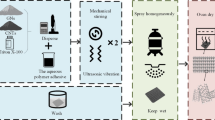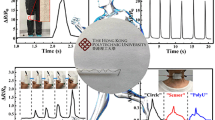Abstract
Electrical strain sensing and e-heating at low voltage with high stability is indeed an essential element for wearable smart textiles. These sensors can be used to detect slight changes in electrical signal due to small deformation caused by mechanical changes such as throat vibration, heart pulse, and body movement. Herein, we demonstrate a simple and systematic tactic to fabricate a carbon nanotube yarn (CNT yarn, CNTY) with excellent strength and superior electrical conductivity. We analyzed different crucial parameters to enhance the sensing response of CNTY by cross-linking method. A novel combined strategy was used to prepare cross-linked and densified CNTY for conductive properties. The modified CNTY showed enhanced sensing properties with a gauge factor improvement from 1.3 to 2.1 at ~ 3% strain. Furthermore, we also assessed the strain sensing behavior of CNTY sewed in the textiles garment. It was noticed that these modifications with cross-linking and densification provide a significant improvement in e-heating properties which open a new path to design and develop smart textiles with combined features.







Similar content being viewed by others
Data availability
All the data recorded or investigated during this research work are mentioned in this article.
References
M. Amjadi et al., Stretchable, skin-mountable, and wearable strain sensors and their potential applications: A review. Adv. Funct. Mater. 26(11), 1678–1698 (2016)
T.Q. Trung et al., Transparent, stretchable, and rapid-response humidity sensor for body-attachable wearable electronics. Nano. Res. 10(6), 2021–2033 (2017)
H.R. Lim et al., Advanced soft materials, sensor integrations, and applications of wearable flexible hybrid electronics in healthcare, energy, and environment. Adv. Mater. 32(15), 1901924 (2020)
W.A.D.M. Jayathilaka et al., Significance of nanomaterials in wearables: a review on wearable actuators and sensors. Adv. Mater. 31(7), 1805921 (2019)
J.-H. Pu et al., 2D end-to-end carbon nanotube conductive networks in polymer nanocomposites: a conceptual design to dramatically enhance the sensitivities of strain sensors. Nanoscale 10(5), 2191–2198 (2018)
K. Suzuki et al., Rapid-response, widely stretchable sensor of aligned MWCNT/elastomer composites for human motion detection. Acs Sens. 1(6), 817–825 (2016)
N. López-Salas, M. Antonietti, Carbonaceous materials: the beauty of simplicity. Bull. Chem. Soc. Jpn. 94(12), 2822–2828 (2021)
Y. **ao et al., Precision measurements of temperature-dependent and Nonequilibrium Thermal Emitters. Laser Photonics Rev. 14(8), 1900443 (2020)
Y. Ding et al., Hollow Cu2O nanospheres loaded with MoS2/reduced graphene oxide nanosheets for ppb-level NO2 detection at room temperature. J. Hazard. Mater. 416, 126218 (2021)
Y. Cui et al., XPM-Induced vector asymmetrical soliton with spectral period doubling in mode-locked fiber laser. Laser and Photonics Rev. 15(3), 2000216 (2021)
J. Wei et al., Enhanced performance of light-controlled conductive switching in hybrid cuprous oxide/reduced graphene oxide (cu 2 O/rGO) nanocomposites. Opt. Lett. 42(5), 911–914 (2017)
J. You et al., Hybrid/integrated silicon photonics based on 2D materials in optical communication nanosystems. Laser Photonics Rev. 14(12), 2000239 (2020)
M.F. De Volder et al., Carbon nanotubes: present and future commercial applications. Science 339(6119), 535–539 (2013)
F. Xu et al., In-plane mechanical properties of carbon nanotube films fabricated by floating catalyst chemical vapor decomposition. J. Mater. Sci. 50(24), 8166–8174 (2015)
Q. Zhang et al., A shapeable, ultra-stretchable rubber strain sensor based on carbon nanotubes and ag flakes via melt-mixing process. J. Mater. Chem. B 9(16), 3502–3508 (2021)
L. Liu, Q. Yang, J. Shen, Correlation between porosity and electrical-mechanical properties of carbon nanotube buckypaper with various porosities. J. Nanomat. (2015). https://doi.org/10.1155/2015/945091
A. Lekawa-Raus et al., Electrical properties of carbon nanotube based fibers and their future use in electrical wiring. Adv. Funct. Mater. 24(24), 3661–3682 (2014)
J.-Z. Chen et al., Ultrafast synthesis of carbon-nanotube counter electrodes for dye-sensitized solar cells using an atmospheric-pressure plasma jet. Carbon 98, 34–40 (2016)
T. Goto et al., Movable cross-linked elastomer with aligned carbon nanotube/nanofiber as high thermally conductive tough flexible composite. Compos. Sci. Technol. 190, 108009 (2020)
W. Li et al., Effect of thermal treatments on structures and mechanical properties of aerogel-spun carbon nanotube fibers. Mater. Lett. 183, 117–121 (2016)
Y. Zhao et al., Iodine doped carbon nanotube cables exceeding specific electrical conductivity of metals. Sci. Rep. 1(1), 1–5 (2011)
B. Mu et al., Relation of the electrical conductivity and the thermal conductivity to the young’s modulus of buckypapers. Int. J. Thermophys. 42(4), 1–11 (2021)
W. Chen et al., Characterization and comparison of properties of cryogenic conditioned CNT reinforced thermoset (epoxy) and thermoplastic (poly vinyl alcohol) composite yarns. J. Composite Mater. (2021). https://doi.org/10.1177/00219983211041764
Y. Jang et al., Carbon nanotube yarn for fiber-shaped electrical sensors, actuators, and energy storage for smart systems. Adv. Mater. 32(5), 1902670 (2020)
H. Ma et al., Wet cryogenic modification of the carbon nanotube assembly inspired by frozen chinese Doufu recipe. Mater. Lett. 303, 130421 (2021)
H. Ma et al., Light-weight strain sensor based on carbon nanotube/epoxy composite yarn. J. Mater. Sci. 56(23), 13156–13164 (2021)
W. Liu et al., Strain sensing fabric integrated with carbon nanotube yarn for wearable applications. Text. Res. J. 89(15), 3048–3055 (2019)
F.I. Farha et al., Microstructural tuning of twisted carbon nanotube yarns through the wet-compression process implications for multifunctional textiles. ACS Appl. Nano Mater. 5(8), 11071–11079 (2022)
Y.R. Lee et al., Improved mechanical and electrical properties of carbon nanotube yarns by wet impregnation and multi-ply twisting. Fibers Polym. 19(12), 2478–2482 (2018)
K. Liu et al., Carbon nanotube yarns with high tensile strength made by a twisting and shrinking method. Nanotechnology 21(4), 045708 (2009)
Z. Wang et al., Bioinspired microstructure-reorganized behavior of carbon nanotube yarn induced by cyclic stretching training. J. Mater. Chem. C 8(1), 117–123 (2020)
W. Li et al., Flexible strain sensor based on aerogel-spun carbon nanotube yarn with a core-sheath structure. Compos. Part A: Appl. Sci. Manufac. 108, 107–113 (2018)
A. Ahmed et al., Preparation of PVDF-TrFE based electrospun nanofibers decorated with PEDOT-CNT/rGO composites for piezo-electric pressure sensor. J. Mater. Sci.: Mater. Electron. 30(15), 14007–14021 (2019)
L. Qiu et al., Functionalization and densification of inter-bundle interfaces for improvement in electrical and thermal transport of carbon nanotube fibers. Carbon 105, 248–259 (2016)
G.S. Kumar, T.U. Patro, Tuning the piezoresistive strain-sensing behavior of poly (vinylidene fluoride)–CNT composites: the role of polymer–CNT interface and composite processing technique. J. Appl. Polym. Sci. 139(3), 51516 (2022)
H. Dong et al., Highly sensitive and stretchable MXene/CNTs/TPU composite strain sensor with Bilayer Conductive structure for human motion detection. ACS Appl. Mater. Interfaces 14(13), 15504–15516 (2022)
H.E. Misak et al., Functionalization of carbon nanotube yarn by acid treatment. Int. J. Smart Nano Mater. 5(1), 34–43 (2014)
M.G. Burdanova et al., Applications of Pristine and Functionalized Carbon Nanotubes, Graphene, and Graphene Nanoribbons in Biomedicine. Nanomaterials 11(11), 3020 (2021)
S. Saleemi et al., Bio-inspired hierarchical carbon nanotube yarn with ester bond cross-linkages towards high conductivity for multifunctional applications. Nanomaterials 12(2), 208 (2022)
R. Maheswaran, B.P. Shanmugavel, A critical review of the role of carbon nanotubes in the progress of next-generation electronic applications. J. Electronic Mater. 51, 1–15 (2022)
A.A. Moosa, A.M. Ridha, I.N. Abdullha, Chromium ions removal from wastewater using carbon nanotubes. Int. J. Innovative Res. Sci. Technol. 4(2), 275–282 (2015)
X. Liang et al., Enhancing the strength, toughness, and electrical conductivity of twist-spun carbon nanotube yarns by π bridging. Carbon 150, 268–274 (2019)
K. Balasubramanian, M. Burghard, Chemically functionalized carbon nanotubes. small 1(2), 180–192 (2005)
F.A. Abuilaiwi et al., Modification and functionalization of multiwalled carbon nanotube (MWCNT) via fischer esterification. Arab. J. Sci. Eng. 35(1), 37–48 (2010)
I.A. Ventura, J. Zhou, G. Lubineau, Investigating the inter-tube conduction mechanism in polycarbonate nanocomposites prepared with conductive polymer-coated carbon nanotubes. Nanoscale Res. Lett. 10(1), 1–5 (2015)
S. Choi et al., A study on reducing contact resistance in solution-processed organic field-effect transistors. ACS Appl. Mater. Interfaces 8(37), 24744–24752 (2016)
X. Liu et al., Highly tough and strain sensitive plasma functionalized carbon nanotube/epoxy composites. Compos. Part A: Appl. Sci. Manufac. 121, 123–129 (2019)
I.A. Rashid et al., Stretchable strain sensors based on polyaniline/thermoplastic polyurethane blends. Polym. Bull. 77(3), 1081–1093 (2020)
F. Guo et al., Fabrication of highly conductive carbon nanotube fibers for electrical application. Mater. Res. Express 2(9), 095604 (2015)
T. Theodosiou, D. Saravanos, Numerical investigation of mechanisms affecting the piezoresistive properties of CNT-doped polymers using multi-scale models. Compos. Sci. Technol. 70(9), 1312–1320 (2010)
N. Hu et al., Tunneling effect in a polymer/carbon nanotube nanocomposite strain sensor. Acta Mater. 56(13), 2929–2936 (2008)
C.D. Hernandez et al., Multifunctional characteristics of carbon nanotube (CNT) yarn composites. In Multifunctional Nanocomposites and Nanomaterials International Conference (2006). https://doi.org/10.1115/MN2006-17028
R. Zhang et al., Carbon nanotube polymer coatings for textile yarns with good strain sensing capability. Sens. Actuators A: Phys. 179, 83–91 (2012)
Z. Tang et al., Highly stretchable core–sheath fibers via wet-spinning for wearable strain sensors. ACS Appl. Mater. Interfaces 10(7), 6624–6635 (2018)
X. Wei et al., Highly stretchable electro-conductive yarn via wrap** carbon nanotube yarn on multifilament polyester yarn. J. Ind. Text. 51(3_suppl), 4589S–4602S (2022)
S.I. Cha et al., Mechanical and electrical properties of cross-linked carbon nanotubes. Carbon 46(3), 482–488 (2008)
J. Chen et al., Advances in responsively conductive polymer composites and sensing applications. Polym. Rev. 61(1), 157–193 (2021)
M. Ehsani, P. Rahimi, Y. Joseph, Structure–function Relationships of Nanocarbon/Polymer Composites for Chemiresistive sensing: a review. Sensors 21(9), 3291 (2021)
F. Xu et al., Highly stretchable, fast thermal response carbon nanotube composite heater. Compos. Part A: Appl. Sci. Manufac. 147, 106471 (2021)
S.K. Pal et al., Thermal and electrical transport along MWCNT arrays grown on inconel substrates. J. Mater. Res. 23(8), 2099–2105 (2008)
A. Khalid et al., Case study of MHD blood flow in a porous medium with CNTS and thermal analysis. Case Stud. Therm. Eng. 12, 374–380 (2018)
L. Zhang et al., High-density carbon nanotube buckypapers with superior transport and mechanical properties. Nano Lett. 12(9), 4848–4852 (2012)
D. Wang et al., Highly oriented carbon nanotube papers made of aligned carbon nanotubes. Nanotechnology 19(7), 075609 (2008)
M.A. Aouraghe et al., Flexible, quickly responsive and highly efficient E-heating carbon nanotube film. Compos. Sci. Technol. 183, 107824 (2019)
M.A. Aouraghe et al., Low-voltage activating, fast responding electro-thermal actuator based on carbon nanotube film/PDMS composites. Adv. Fiber Mater. 3(1), 38–46 (2021)
P. Liu et al., Continuous carbon nanotube-based fibers and films for applications requiring enhanced heat dissipation. ACS Appl. Mater. Interfaces 8(27), 17461–17471 (2016)
B. Kumanek, D. Janas, Thermal conductivity of carbon nanotube networks: a review. J. Mater. Sci. 54(10), 7397–7427 (2019)
Acknowledgements
Author would like to thank the Shanghai Natural Science Foundation and Fundamental Research Funds for the Central Universities for their financial support.
Funding
This research work was funded by Shanghai Frontier Science Research Center for Modern Textiles, Donghua University, the Shanghai Natural Science Foundation (Grant No. 20ZR1402200) and Fundamental Research Funds for the Central Universities (Grant No. 2232021G-01).
Author information
Authors and Affiliations
Contributions
S.S. conceptualization, experiment, data collection, analysis, writing, editing. H.A.M. writing, editing. F.X. funding, reviewing, editing, and supervising. All authors read and approved the final manuscript.
Corresponding author
Ethics declarations
Conflicts of interest
The authors declare that there is no conflict of interest.
Additional information
Publisher’s Note
Springer Nature remains neutral with regard to jurisdictional claims in published maps and institutional affiliations.
Supplementary Information
Below is the link to the electronic supplementary material.
Rights and permissions
Springer Nature or its licensor (e.g. a society or other partner) holds exclusive rights to this article under a publishing agreement with the author(s) or other rightsholder(s); author self-archiving of the accepted manuscript version of this article is solely governed by the terms of such publishing agreement and applicable law.
About this article
Cite this article
Saleemi, S., Mannan, H.A. & Xu, F. Nanoarchitectonics of cross-linked densified carbon nanotube yarn for stable conductivity and strain sensing. J Mater Sci: Mater Electron 34, 24 (2023). https://doi.org/10.1007/s10854-022-09452-7
Received:
Accepted:
Published:
DOI: https://doi.org/10.1007/s10854-022-09452-7




